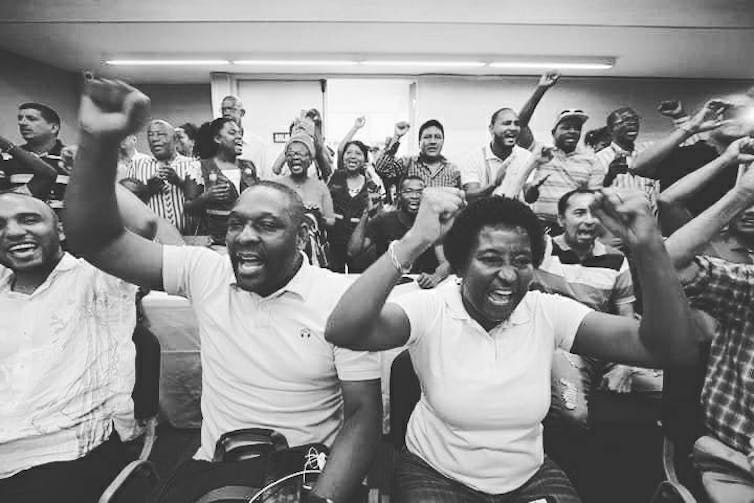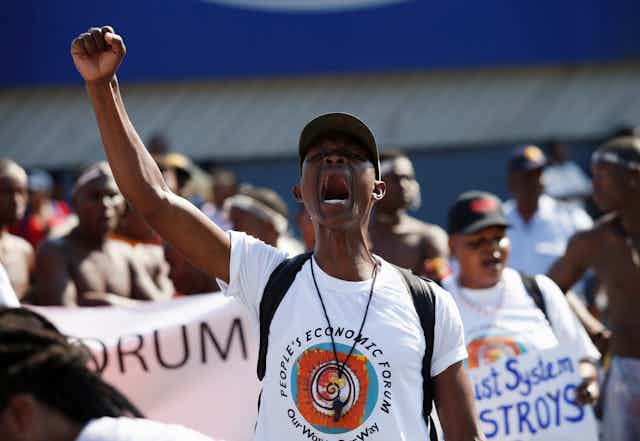Ongoing anti-government demonstrations in Brazil. The Women’s March on Washington. Protesters in Morocco demanding the right to protest and dissent. Philippine citizens marching against President Rodrigo Duterte’s drug war. Hungarian rallies for freedom of information and expression.
As protests, demonstrations and clashes escalate across the world, global discontent seems to be reaching levels not seen since the fallout of the 2008-2009 financial meltdown.
What is driving this wave of popular mobilisation?
Well, inequality, at least in part. When national hopes are raised by new national opportunities and then, in certain sectors of society, dashed by ongoing structural inequality, we see popular protest break out.
Colombia and South Africa offer good examples.
Both countries have highly entrenched inequality, with class, ethnicity, and skin colour defining from birth the opportunities available to their citizens. According to the World Bank, Colombia and South Africa are among the top 10% of the world’s least equal countries.
They are also both in the midst of profound national transitions, with South Africa trying to move beyond the apartheid era and Colombia seeking peace after half a century of armed conflict.
Colombians: loud, and not afraid
Since 2012, Colombia has seen frequent, numerous protests undertaken for varying reasons by different groups. These include peasants, educators, Afro-descendants and indigenous people, coca-leaf farmers and truck drivers, among other constituencies.
This is a relatively new phenomenon for the country. Though Colombia saw its share of protests in the 1960s, the emergence of armed violence over the following decades stifled further citizen mobilisation.
Generally speaking, violence muffles and trumps moderate voices. Thanks to Colombia’s 50-year internal conflict, voices and movements not aligned with either the state or the guerrillas were weak throughout the latter half of the 20th century.
That has changed since the government demobilised Colombia’s paramilitaries in 2006 (a process that, some argue, remains incomplete) and, in late 2016, signed a peace deal with FARC guerrillas.
Today, that great limiting factor that prevented the state from realising its promises to citizens – armed conflict – has disappeared. Gone, too, are Colombians’ fear of reprisal, and their patience for the government’s inability to meet their most basic needs.
Take the city of Buenaventura as an example. For the past three weeks, this very poor port city has seen non-stop protests and a general strike, as Afro-descendants and indigenous residents renounced the discrepancy between the development of large, foreign-funded infrastructure projects and the fact that essentials, such as potable water and basic health care, remain scarce.
Buenaventura also has high levels of crime, including assassinations of citizens by armed groups, and an official unemployment rate of 18% (the national average is 8.9%).
The indignation and frustration of citizens toward the government is at least in part a response to a history of opportunism, corruption, armed violence and racial and economic inequality in Buenaventura – itself a legacy of weak institutions in Colombia’s interior regions – which has not improved with the arrival of peace.
Buenaventura is a striking case of state abandonment, but it is not alone: across the country, Afro-descendants and indigenous populations are subjected to such treatment.
Even as a recent agreement ended the protests in Buenaventura with the government promising to invest US$150 million in the community, a national strike by teachers all but shut down Colombia’s cities earlier this week. Popular discontent cannot be resolved in a day.

South Africa: protest capital of the world
South Africa, with its frequent and plentiful protests, is often dubbed “the protest capital of the world”.
Apartheid, the legally enforced regime of racial separation, subjected more than 80% of the country’s population to systematic oppression for four decades. Black and mixed-race citizens regained their legal rights in 1994, but inequalities still run deep in South African society.
It should come as no surprise then that protests have increased markedly since the end of apartheid, from miners’ strikes to university student movements and marches demanding the resignation of President Jacob Zuma. Many of those marching are South Africa’s people of colour, the poor and the disenfranchised.
These recent uprisings are often referred to as “service delivery protests”, meaning that they seek to reclaim the promises of the country’s 1996 constitution regarding health, unemployment, education, roads, sanitation and housing.
But they are also driven by outrage at the state’s inability to tackle South Africa’s existing – and widening – inequalities. Most of the protests invoke the failed promise of the “rainbow nation”, which vowed to deliver a post-racial and equal society. Instead, South Africans find themselves with the remnants of a myth that has failed to deliver all the promises made: racism, poverty, opportunities and deep inequalities persist.
Frustrated aspirations
The marches taking place in Colombia and South Africa, like those in Morocco, Brazil, the Philippines, Hungary and the United States, share a key feature. They all reflect the contestation of power and citizen demand that the state fulfil the promises enshrined in the constitution.
Inequality gives fuel to this discontent, because where it is salient, social mobility is an empty promise. When citizens are – or feel – disenfranchised by virtue of their race, class, gender or geography, and they perceive an unacceptable gap between their constitutionally guaranteed rights and the real-world realisation of these rights, they get frustrated.
In polities that are in transition, such frustrations may or may not overlap with unhappiness about inadequate or failing state capacity. Effectively moving beyond apartheid and building peace are huge challenges that require not just inspirational rhetoric but a real commitment from governments. In both Colombia and South Africa, the perception that governments are coming up short will continue to dash citizens’ expectations of a better future.
Anger over truncated social mobility can be heightened by cultural globalisation. Today, the aspirations of individuals whose dreams would once have been largely limited to what they observed around them are shaped by global exposure and access.
In this sense, globalisation has been a positive force. It has supported the emergence of the indigenous rights movement, women’s rights, transnational activism and the growth of the human rights, political and environmental frameworks.
Globalisation has, in some cases, also made repression less likely, due to state obligations under international human rights treaties. With increasing integration into the globalised community, the unease and frustration of disenfranchised citizens is likely to increase.
The future of protest
If Colombia or South Africa fail to discern the ways in which inequality is driving citizens to protest and effectively respond to that discontent (as Colombia promised to do in Buenaventura), confidence in state institutions and the state itself will decrease.
That’s a recipe for more protest and, potentially, an escalation of violence.
History reminds us that groups denied adequate, institutionalised democratic participation can come to see the state as illegitimate, leading to revolt. The Syrian civil war came in the wake of protests against the Assad regime’s failure to provide water.
Prevalent inequality also damages trust and social cohesion, making unified national progress nearly impossible. If South Africa hopes to maintain its belief in a post-racial society, and if Colombia is to actually achieve reconciliation, it’s time to start truly tackling inequality.

